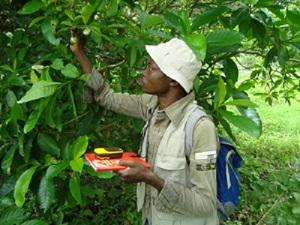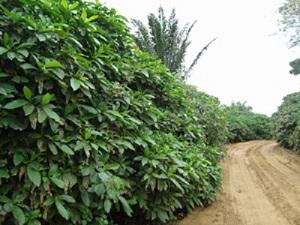Orou Gaoue
Other projects
This project will investigate the extent of harvest of Voacanga africana by local people in Benin and the dynamics of its populations to assess any reduction in population size as a consequence of harvest or other environmental factors, and communicate this and conservation actions needed to local forest authorities and NGOs in Benin.

Examining V. africana fruits during fieldwork.
The conservation of endangered species in Africa is hampered by the lack of appropriate technical information to decide on management options. Our research group is interested in documenting the dynamics of threatened medicinal plants harvested by local people to ensure that we know about how sustainable (or not) current harvesting practices are, identify sources of threat and suggest conservation actions.

A population of V. africana along roadside.
Our first project successfully identified that Rauvolfia vomitoria, an important medicinal plant heavily used by indigenous people in Benin to treat psychiatric diseases, is now limited to disturbed habitats where the shortening of the fallow cycle is a discrete threat to its long term persistence. During this study we observed that Voacanga africana, another medicinal plant, is occurring in different habitat and may be going extinct at local level due to fragmentation and harvesting of its seeds, bark and leaves.
Voacanga africana (Apocynaceae) is an endangered medicinal plants widely used by local people in Africa and part of the international trade. Alkaloids from its seed, bark and leaves have antiulcerogenic, anticonvulsant, sedative property of interest for the health industry and in treating drug addiction. Our current project will investigate the extent of harvest of V. africana organs (seeds, bark, foliage) at individual and population levels and existence of any trade network. This project will also assess the ecological health of V. africana populations across Benin by studying its population structure to infer its short and long-term dynamics.
This project will add to our understanding how V. africana population size varies across its distribution range in Benin and identify the environmental factors that reduce its density and/or jeopardized the long-term persistence of the species in its habitat.
The outcomes of this project will provide the forestry department and non-profit nature conservancy organizations, with missing information necessary to justify many of their field activities, and also provide technical information for sustainable management plan of the species. To raise awareness, we propose to use a strategic communication approach with farmers and forest authorities at local and national levels to inform them about the real threat to extinction faced by our study species and many other similar species.